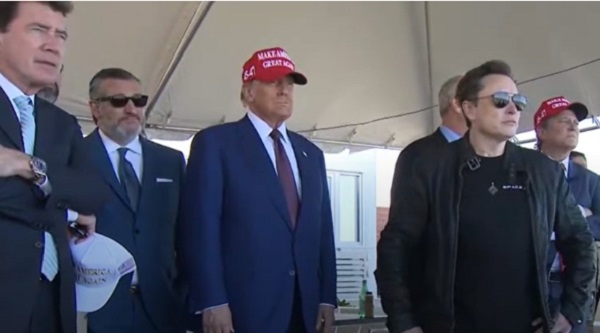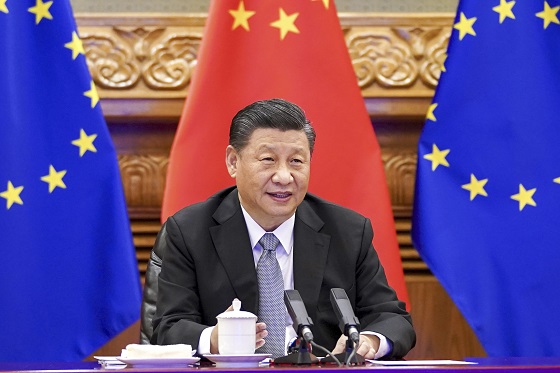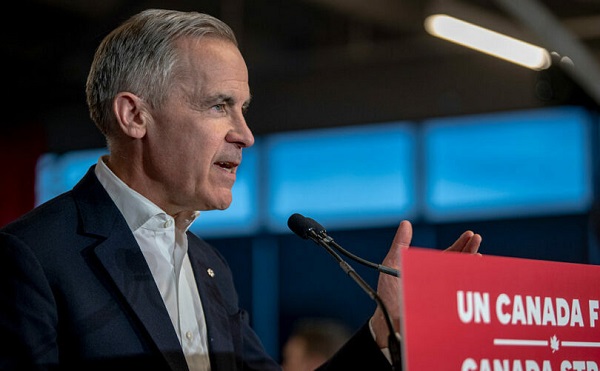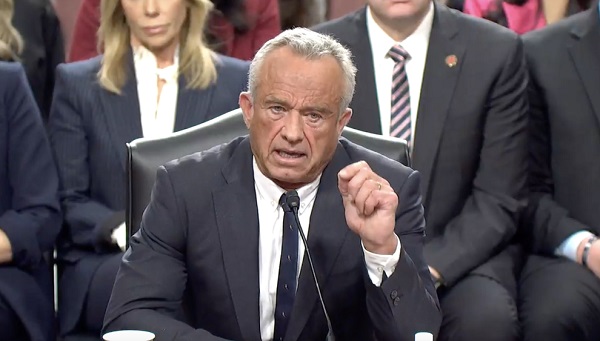Business
Trump’s Initial DOGE Executive Order Doesn’t Quite ‘Dismantle Government Bureaucracy’


From the Daily Caller News Foundation
By Thomas English
President Donald Trump’s Monday executive order establishing the Department of Government Efficiency (DOGE) presents a more modest scope for the initiative, focusing primarily on “modernizing federal technology and software.”
The executive order refashions the Obama-era United States Digital Service (USDS) into the United States DOGE Service. Then-President Barack Obama created USDS in 2014 to enhance the reliability and usability of online federal services after the disastrous rollout of HealthCare.gov, an insurance exchange website created through the Affordable Care Act (ACA). Trump’s USDS will now prioritize “modernizing federal technology and software to maximize efficiency and productivity” under the order, which makes no mention of slashing the federal budget, workforce or regulations — DOGE’s originally advertised purpose.
“I am pleased to announce that the Great Elon Musk, working in conjunction with American Patriot Vivek Ramaswamy, will lead the Department of Government Efficiency (‘DOGE’),” Trump said in his official announcement of the initiative in November. “Together, these two wonderful Americans will pave the way for my Administration to dismantle Government Bureaucracy, slash excess government regulations, cut wasteful expenditures, and restructure Federal Agencies.”
The order’s focus on streamlining federal technology and software stands in contrast to some of DOGE’s previously more expansive aims, including Elon Musk’s claim that “we can [cut the federal budget] by at least $2 trillion” at Trump’s Madison Square Garden rally in November. Musk now leads DOGE alone after Vivek Ramaswamy stepped down from the initiative Monday, apparently eying a 2026 gubernatorial run in Ohio.
The order says it serves to “advance the President’s 18-month DOGE agenda,” but omits many of the budget-cutting and workforce-slashing proposals during Trump’s campaign. Rather, the order positions DOGE as a technology modernization entity rather than an organization with direct authority to enact sweeping fiscal reforms. There is no mention, for instance, of trillions in budget cuts or a significant reduction in the federal workforce, though the president did separately enact a hiring freeze throughout the executive branch Monday.
“I can’t help but think that there’s more coming, that maybe more responsibilities will be added to it,” Susan Dudley, a public policy professor at George Washington University, told the Daily Caller News Foundation. Dudley, who was also the top regulatory official in former President George W. Bush’s administration, said the structure of the new USDS could impact the recent lawsuits against the DOGE effort.
“I think it maybe moots the lawsuit that’s been brought for it not being FACA,” Dudley said. “So if this is how it’s organized — that it’s people in the government who bring in these special government employees on a temporary basis, that might mean that the lawsuit doesn’t really have any ground.”
Three organizations — the American Federation of Government Employees (AFGE), National Security Counselors (NSC) and Citizens for Responsibility and Ethics in Washington (CREW) — separately filed lawsuits against DOGE within minutes of Trump signing the executive order. The suits primarily challenge DOGE’s compliance with the Federal Advisory Committee Act (FACA), alleging the department operates without the required transparency, balanced representation and public accountability.
The order also emphasizes not “be construed to impair or otherwise affect … the authority granted by law to an executive department or agency, or the head thereof; or the functions of the Director of the Office of Management and Budget relating to budgetary, administrative, or legislative proposals.”
“And the only mention of OMB [Office of Management and Budget] is some kind of boilerplate at the end — that it doesn’t affect that. But that’s kind of general stuff you often see in executive orders,” Dudley continued, adding she doesn’t “have an inside track” on whether further DOGE-related executive orders will follow.
“It’s certainly, certainly more modest than I think Musk was anticipating,” Dudley said.
Trump’s order also establishes “DOGE Teams” consisting of at least four employees: a team lead, a human resources specialist, an engineer and an attorney. Each team will be assigned an executive agency with which it will implement the president’s “DOGE agenda.”
It remains unclear whether Monday’s executive order comprehensively defines DOGE, or if additional orders will be forthcoming to broaden its mandate.
Business
Is Government Inflation Reporting Accurate?


 David Clinton
David Clinton
Who ya gonna believe: official CPI figures or your lyin’ eyes?
Great news! We’ve brought inflation back under control and stuff is now only costing you 2.4 percent more than it did last year!
That’s more or less the message we’ve been hearing from governments over the past couple of years. And in fact, the official Statistics Canada consumer price index (CPI) numbers do show us that the “all-items” index in 2024 was only 2.4 percent higher than in 2023. Fantastic.
So why doesn’t it feel fantastic?
Well statistics are funny that way. When you’ve got lots of numbers, there are all kinds of ways to dress ‘em up before presenting them as an index (or chart). And there really is no one combination of adjustments and corrections that’s definitively “right”. So I’m sure Statistics Canada isn’t trying to misrepresent things.
But I’m also curious to test whether the CPI is truly representative of Canadians’ real financial experiences. My first attempt to create my own alternative “consumer price index”, involved Statistics Canada’s “Detailed household final consumption expenditure”. That table contains actual dollar figures for nation-wide spending on a wide range of consumer items. To represent the costs Canadian’s face when shopping for basics, I selected these nine categories:
- Food and non-alcoholic beverages
- Clothing and footwear
- Housing, water, electricity, gas and other fuels
- Major household appliances
- Pharmaceutical products and other medical products (except cannabis)
- Transport
- Communications
- University education
- Property insurance
I then took the fourth quarter (Q4) numbers for each of those categories for all the years between 2013 and 2024 and divided them by the total population of the country for each year. That gave me an accurate picture of per capita spending on core cost-of-living items.
Overall, living and breathing through Q4 2013 would have cost the average Canadian $4,356.38 (or $17,425.52 for a full year). Spending for those same categories in Q4 2024, however, cost us $6,266.48 – a 43.85 percent increase.
By contrast, the official CPI over those years rose only 31.03 percent. That’s quite the difference. Here’s how the year-over-year changes in CPI inflation vs actual spending inflation compare:
As you can see, with the exception of 2020 (when COVID left us with nothing to buy), the official inflation number was consistently and significantly lower than actual spending. And, in the case of 2021, it was more than double.
Since 2023, the items with the largest price growth were university education (57.46 percent), major household appliances (52.67 percent), and housing, water, electricity, gas, and other fuels (50.79).
Having said all that, you could justifiably argue that the true cost of living hasn’t really gone up that much, but that at least part of the increase in spending is due to a growing taste for luxury items and high volume consumption. I can’t put a precise number on that influence, but I suspect it’s not trivial.
Since data on spending doesn’t seem to be the best measure of inflation, perhaps I could build my own basket of costs and compare those numbers to the official CPI. To do that, I collected average monthly costs for gasoline, home rentals, a selection of 14 core grocery items, and taxes paid by the average Canadian homeowner.¹ I calculated the tax burden (federal, provincial, property, and consumption) using the average of the estimates of two AI models.
How did the inflation represented by my custom basket compare with the official CPI? Well between 2017 and 2024, the Statistics Canada’s CPI grew by 23.39 percent. Over that same time, the monthly cost of my basket grew from $4,514.74 to $5,665.18; a difference of 25.48 percent. That’s not nearly as dramatic a difference as we saw when we measured spending, but it’s not negligible either.
The very fact that the government makes all this data freely available to us is evidence that they’re not out to hide the truth. But it can’t hurt to keep an active and independent eye on them, too.
Subscribe to The Audit.
For the full experience, upgrade your subscription.
2025 Federal Election
Carney’s Hidden Climate Finance Agenda

From Energy Now
By Tammy Nemeth and Ron Wallace
It is high time that Canadians discuss and understand Mark Carney’s avowed plan to re-align capital with global Net Zero goals.
Mark Carney’s economic vision for Canada, one that spans energy, housing and defence, rests on an unspoken, largely undisclosed, linchpin: Climate Finance – one that promises a Net Zero future for Canada but which masks a radical economic overhaul.
Regrettably, Carney’s potential approach to a Net Zero future remains largely unexamined in this election. As the former chair of the Glasgow Financial Alliance for Net Zero (GFANZ), Carney has proposed new policies, offices, agencies, and bureaus required to achieve these goals.. Pieced together from his presentations, discussions, testimonies and book, Carney’s approach to climate finance appears to have four pillars: mandatory climate disclosures, mandatory transition plans, centralized data sharing via the United Nations’ Net Zero Data Public Utility (NZDPU) and compliance with voluntary carbon markets (VCMs). There are serious issues for Canada’s economy if these principles were to form the core values for policies under a potential Liberal government.
About the first pillar Carney has been unequivocal: “Achieving net zero requires a whole economy transition.” This would require a restructuring energy and financial systems to shift away from fossil fuels to renewable energy with Carney insisting repeatedly in his book that “every financial [and business] decision takes climate change into account.” Climate finance, unlike broader sustainable finance with its Environmental, Social, and Governance (ESG) focus would channel capital into sectors aligned with a 2050 Net Zero trajectory. Carney states: “Companies, and those who invest in them…who are part of the solution, will be rewarded. Those lagging behind…will be punished.” In other words, capital would flow to compliant firms but be withheld from so-called “high emitters”.
How will investors, banks and insurers distinguish solution from problem? Mandatory climate disclosures, aligned with the International Sustainability Standards Board (ISSB), would compel firms to report emissions and outline their Net Zero strategies. Canada’s Sustainability Standards Board has adopted these methodologies, despite concerns they would disadvantage Canadian businesses. Here, Carney repeatedly emphasizes disclosures as the cornerstone to track emissions data required to shift capital away from “high emitters”. Without this, he claims, large institutional investors lack the data on supply chains to make informed decisions to shift capital to businesses that are Net Zero compliant.
The second pillar, Mandatory Transition Plans would require companies to map a 2050 Net Zero trajectory for emission reduction targets. Failure to meet those targets would invite pressure from investors, banks, or activists, who may pursue litigation for non-compliance. The UK’s Transition Plan Task Force, now part of ISSB, provides this standardized framework. Carney, while at GFANZ, advocated using transition plans for a “managed phase-out” of high-emitting assets like coal, oil and gas, not just through divestment but by financing emissions reductions. “As part of their transition planning, [GFANZ] members should establish and apply financing policies to phase out and align carbon-intensive sectors and activities, such as thermal coal, oil and gas and deforestation, not only through asset divestment but also through transition finance that reduces real world emissions. To assist with these efforts GFANZ will continue to develop and implement a framework for the Managed Phase-out of high-emitting assets.” Clearly, the purpose of this is to ensure companies either decarbonize or face capital withdrawal.
The third pillar is the United Nations’ Net Zero Data Public Utility (NZDPU), a centralized platform for emissions and transition data. Carney insists these data be freely accessible, enabling investors, banks and insurers to judge companies’ progress to Net Zero. As Carney noted in 2021: “Private finance is judging…banks, pension funds and asset managers have to show where they are in the transition to Net Zero.” Hence, compliant firms would receive investment; laggards would face divestment.
Finally, voluntary carbon markets (VCMs) allow companies to offset emissions by purchasing credits from projects like reforestation. Carney, who launched the Taskforce on Scaling VCMs in 2020, has insisted on monitoring, verification and lifecycle tracking. At a 2024 Beijing conference, he suggested major jurisdictions could establish VCMs by COP 30 (planned for 2025 in Brazil) to create a global market. If Canada mandates VCMs, businesses especially small and medium enterprises (SMEs) would face much higher compliance costs with credits available only to those that demonstrate progress with transition plans.
These potential mandatory disclosures and transition plans would burden Canadian businesses with material costs and legal risks that constitute an economic gamble which few may recognize but all should weigh. Do Canadians truly want a government that has an undisclosed climate finance agenda that would be subservient to an opaque globalized Net Zero agenda?
Tammy Nemeth is a U.K.-based strategic energy analyst. Ron Wallace is an executive fellow of the Canadian Global Affairs Institute and the Canada West Foundation.
-

 Business2 days ago
Business2 days agoTrump: China’s tariffs to “come down substantially” after negotiations with Xi
-

 2025 Federal Election2 days ago
2025 Federal Election2 days agoPolice Associations Endorse Conservatives. Poilievre Will Shut Down Tent Cities
-

 Business2 days ago
Business2 days agoTrump considers $5K bonus for moms to increase birthrate
-

 Business1 day ago
Business1 day agoChinese firm unveils palm-based biometric ID payments, sparking fresh privacy concerns
-

 2025 Federal Election2 days ago
2025 Federal Election2 days agoCanada’s press tries to turn the gender debate into a non-issue, pretend it’s not happening
-

 2025 Federal Election2 days ago
2025 Federal Election2 days agoNext federal government should end corporate welfare for forced EV transition
-

 COVID-192 days ago
COVID-192 days agoRFK Jr. Launches Long-Awaited Offensive Against COVID-19 mRNA Shots
-

 2025 Federal Election18 hours ago
2025 Federal Election18 hours agoCarney’s Hidden Climate Finance Agenda






